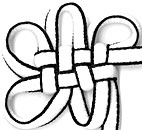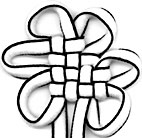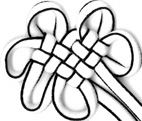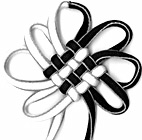Mystic Knots: Some Assembly Required
 While the flower knot, when
considered as a polygonal knot, is a family unto itself with many
(many!) variations starting with the number of petals
(ears) and the ways that the structural loops
interlace, the basic square flower knot is also the basic unit of the
mystic knot (see right). Now flower knots can be chained
together via their ears as in the case of the ru-yi knot, but if you
instead extend the structural loops and weave through
them appropriately, you begin to build up a mystic knot.
While the flower knot, when
considered as a polygonal knot, is a family unto itself with many
(many!) variations starting with the number of petals
(ears) and the ways that the structural loops
interlace, the basic square flower knot is also the basic unit of the
mystic knot (see right). Now flower knots can be chained
together via their ears as in the case of the ru-yi knot, but if you
instead extend the structural loops and weave through
them appropriately, you begin to build up a mystic knot.
 By extending the horizontal
structural loops and weaving one extra loop from the top and one from
the bottom, you’ve created a knot with 2 square flower knots (let’s
call this the mystic unit, shall we?) side by side.
I tend to call this the 2x1 mystic knot (see
left). Since it’s a knot that you can pick up and rotate at
will, there’s no difference between a 2x1 and a 1x2 knot although if
you were making clockwise versus counterclockwise mystic
units… aigh!! I’ll think about that later. In any case, you cannot
put CW and CCW mystic units together in a 2x1 knot and have a stable
knot (although, maybe if you sideline it in a non-standard
way…!?).
By extending the horizontal
structural loops and weaving one extra loop from the top and one from
the bottom, you’ve created a knot with 2 square flower knots (let’s
call this the mystic unit, shall we?) side by side.
I tend to call this the 2x1 mystic knot (see
left). Since it’s a knot that you can pick up and rotate at
will, there’s no difference between a 2x1 and a 1x2 knot although if
you were making clockwise versus counterclockwise mystic
units… aigh!! I’ll think about that later. In any case, you cannot
put CW and CCW mystic units together in a 2x1 knot and have a stable
knot (although, maybe if you sideline it in a non-standard
way…!?).
 What was I talking about?
Oh, right… If you then extend the structural loops on one side
vertically and weave through that in turn you get a little ‘L’ shaped
mystic knot composed of 3 mystic units (see right).
What was I talking about?
Oh, right… If you then extend the structural loops on one side
vertically and weave through that in turn you get a little ‘L’ shaped
mystic knot composed of 3 mystic units (see right).
 And if you
turn that knot 45° then it looks like a heart (or a ‘V’, see
left). But maybe it helps the heart idea if it’s red and pink</em>.
And if you
turn that knot 45° then it looks like a heart (or a ‘V’, see
left). But maybe it helps the heart idea if it’s red and pink</em>.
So, if you extend all the structural loops
then you get the classic (2x2) mystic knot (see
right).
Now, imagine making a design on graph paper. Any solid shape can be made using mystic units. I have seen a mystic knot version of the map of Taiwan. Further, designs with holes can also be made, although sometimes the pathfinding can be a bit tricky and cords might need to travel through the hollow space inside the knot to help out. A mathematician who studies tiling or maybe path finding should be able to help us out with limits and parameters.
Speaking of the hollow space inside the knot, the mystic knot, in weaving terms is a double woven pocket. Now someone who weaves can probably correct me if I’m wrong here (please do!). Double weave is made on a single loom woven in such a way that 2 layers of cloth are generated (sometimes occasionally interconnected, but for our purposes, not. At least not except at the edges). If the weave is connected only on one side, you get a double-wide piece of cloth (unless you cut it to get 2 separate layers of cloth). If the weave is connected on 2 sides, you get a tube of cloth. If the weave is connected on 3 sides you get a pocket. If the weave is connected on 4 sides you get a closed pocket. The mystic knot is a closed pocket. Compared to most fabric, however, it is a very large scale thing and it is very easy to open a gap into which things can be put and then reseal the pocket. I’ve seen projects where a mystic knot is turned into a potpourri or moth repellent sachet by stuffing the pocket with the appropriate substance.
Speaking of putting things into the pocket… I was reading this article about the magic of knots (via) and thinking that the mystic knot would be a perfect spell knot. There’s the pocket to put other spell components into, you’ll have plenty of time to say spells and consider the spell recipient as you weave it, and it’s flatter than a monkey’s fist making it more comfortable to wear under your clothes. But then not being a believer or much of a student of the matter, maybe I’m wrong. 8)